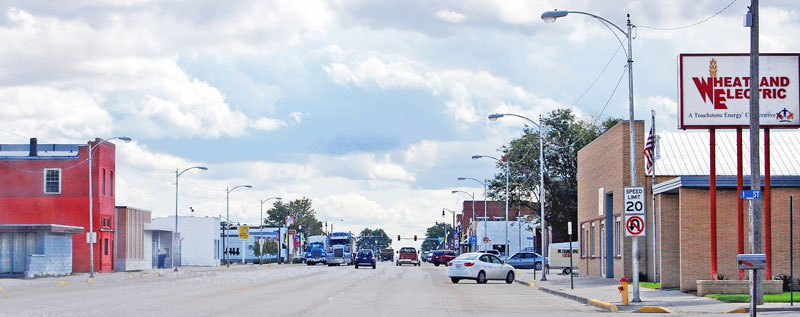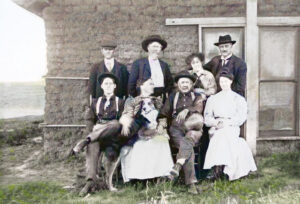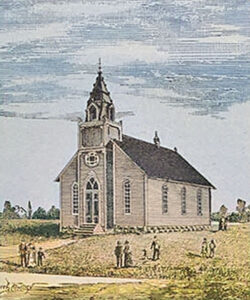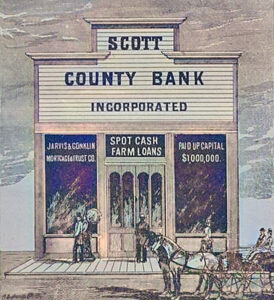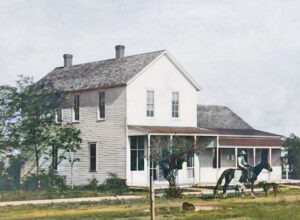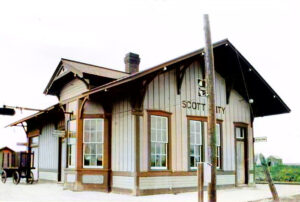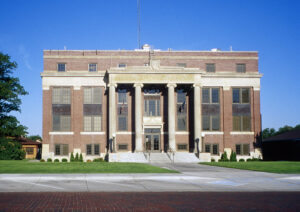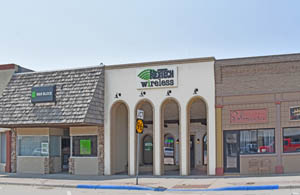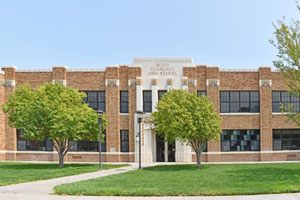Scott City, Kansas, is a city and the county seat of Scott County. As of the 2020 census, the city’s population was 4,113, and it had a total area of 2.63 square miles, all land. It is located in the Great Plains at an elevation of 2979 feet.
A post office called Scott Centre was opened on March 24, 1880. However, it closed about eight months later on October 14, 1880.
On the high plains of Kansas, Maria E. De Geer, a most unusual and progressive woman, came from Chicago, Illinois, to establish a temperance community in 1884. She chose the very center of Scott County for her settlement, filed her claim in September 1884, and built a cabin. Along with her daughter, many of her friends, and others, she began proving up claims over the next year in what is now Scott City.
In February 1885, two men from Chicago arrived at the cabin and settled there. Mrs. Maria E. De Geer, one of the women who came from Chicago, started the Western Times newspaper in March 1885. Three men and a woman began the Town Company and laid out a town site the same month. Mrs. DeGeer, Mr. Swan, Mr. McLain, and Mr. Case each donated 40 acres to begin the townsite, which was known as Scott Centre. Soon after, many people started arriving in the county. At that time, Scott City was known as Scott Centre.
The Town Company of Scott City was organized and incorporated on September 11, 1885. The town company donated a block of land to the county for a courthouse site, a block to the city for school purposes, a lot to each of four church organizations, and each member of the Town Company donated one acre for a park, so four parks were laid out. Like Scott County, the city is named in recognition of a United States General, Winfield Scott. More than 50 buildings were built over the next 90 days. The Town Company offered a free lot to anyone who would build on it. They also donated land for the first church in Scott City.
On December 14, 1885, the post office was reinstated under the name of Scott.
Within a year, the population was 600, with three newspapers — the News, the Sentinel, and the Herald, as well as numerous retail establishments.
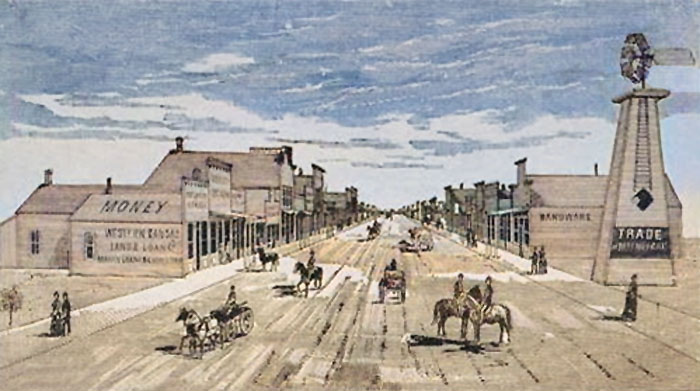
Scott City, Kansas, Main Street, 1886.
On January 1, 1886, Scott City had a population of 700 and was rapidly growing. At that time, Scott City boasted three weekly newspapers, four banks, a board of trade, two hotels, and 50 additional businesses. The community had thriving organizations, including lodges of the Masons, Odd Fellows, and Good Templars, as well as a post of the Grand Army of the Republic and the Women’s Christian Temperance Union. That year, the ladies of the Women’s Christian Temperance Union constructed a two-story building. The first floor was leased to the county for official and clerical purposes, while the hall on the upper level served for literary and social gatherings. They also established a public library and reading room. The Methodist Church was the first place of worship built in the community. The Cumberland Presbyterian Church was also established that year.
Scott City had many land and loan men in 1886. Dr. D.F. Hall laid out a 104-acre addition to the northeast division of the original townsite and sold many business and residence sites. Frank H. Miller became primarily interested in both city and country property and, in 1886, established the Traders’ Bank. He also amassed a substantial fortune by handling Scott City property. The Scott City Real Estate Company, with Frank A. Capps as president and Charles Clark as secretary, opened a land-and-loan office. Thompson, McNabb & Landis, real estate and loan agents, did a large business. James H. Camfill organized the Western Kansas Land and Loan Company, but in 1887, he sold his interests to Tom Kennedy of Harper, Kansas. Messrs. S.L. Hughes and P.H. O’Gara conducted the company’s land department. Smith, McLain & Company, land and loan agents and land attorneys, with W.O. Bourne as junior member of the firm. Mr. Bourne had a fine suburban claim. Morse & Perry, a real estate and loan firm, began business in 1887. Kelley & Fitts also did a capital business in real estate and farm loans.
Johnson Brothers & Service, whose bank was founded in February 1886, was the county’s pioneering banking house and a strong, well-organized concern. The Scott County Bank was also incorporated in that year by Samuel M. Jarvis, R.R. Conklin, C.G. Larned, H.J. Hunt, F.A. Parsons, and J.D. Jarvis, and opened its doors with a capital of $50,000. The Traders Bank was also organized in 1886 by Frank N. Miller and friends. It was shortly reorganized, the new incorporators being ex-Governor George W. Glick and S. B. Glazier, of Atchison, W.L.C. Beard, M.J. Keys, and Frank H. Miller.
Prominent among the professional men were Traverse Morse, an attorney; Messrs. Hadley and Hubbell, the former county attorney and the latter county superintendent of schools. The medical profession was finely represented by Dr. J.F. Bond, who was the first doctor to settle in Scott County; Dr. Ira W. Bouldin; and Dr. Arbuthnot, physician and druggist, whose partner in the drug business was Mr. Eggleston, a breeder of thoroughbred horses and farmer.
In August 1886, the county seat was relocated to Scott Center by unanimous vote. The first courthouse was held in the Women’s Christian Temperance Union Building on Main Street.
Scott City became a third-class incorporated city on January 10, 1887. Prior to that time, it had operated as a village. The board of county commissioners designated the boundaries upon the request of a petition signed by a majority of the village’s residents, and an election was called for February 17, 1887. The first mayor elected was James B. Johnson; the police judge, L.S. Boyer; and the councilmen, Frank H. Miller, Cy Brookman, W. Meisenheimer, John Eckard, and Thomas Crook.
The new city officers found some trouble from the outset. They had no money to pay bills, and it would be several months before a tax levy could be levied. The problem was solved by the occupation tax method, and so far, as is known, the expenses were paid from that fund until tax money could be collected.
The land incorporated into the city consisted of quarters from four different sections and was located on a small knoll, so that water drained in every direction from the main city square, which was the intersection of Main and De Geer streets. De Geer Street was later changed to Fifth Street. Each quarter of land had been filed on as a homestead, and the four owners constituted the Town Company.
A fourth bank was opened in 1887 under the firm name of McKnight & Nicholson.
The original frame courthouse was constructed in 1888 on the Northeast corner of the courthouse square.
The city flourished in the years leading up to 1890, but a few setbacks — crop failure and the bursting of the boom — came in the way.
At one time, Scott City had a population of over 2,000, but during the 1890s, the population dwindled.
The brick school building, built in 1894, was in the northeast park.
By 1902, Scott City had a bank, four general stores, a high school, a drug store, a lumber yard, an opera house, and several churches, along with the Missouri Pacific and the Atchison, Topeka, and Santa Fe rail lines. By 1903, the population of Scott City had dwindled to about 350.
From 1900 to 1910, Scott City’s population increased from 212 to 918.
In 1910, Scott City was an incorporated city of the third class, located on the Atchison, Topeka & Santa Fe Railroad, the Missouri Pacific Railroad, and the Garden City, Gulf & Northern Railroad, in the central part of the county. At that time, it had two banks, two weekly newspapers — the Chronicle and the News-Lever, two flour mills, two grain elevators, and was home to the county high school. Situated within a large farming district, it was the only incorporated town in the county. At that time, it had telegraph and express offices, as well as an international money order post office.
On October 9, 1913, the town’s name was changed from Scott to Scott City.
In 1914, the first electric light and power plant was built. The equipment cost $40,000 and was adequate, but by 1920, a new, larger plant was needed. In 1931, Scott City sold the plant to the Inland Utilities Company of Kansas City, which rebuilt it, added larger motors, and extended lines to rural areas.
A sewer system was installed in 1920, and new water wells were put down.
The current Scott County courthouse was constructed in 1924 and 1925 on the square where the original courthouse had stood, which had been torn down. Located at 303 Court Street and West 4th Street, the Classical Revival building was designed by Mann & Company of Hutchinson, Kansas, and built by Henderson & Riggs. The three-story red brick and concrete structure is located on landscaped grounds in the center of Scott City. The building has a raised basement and four large columns on the east side that support a large stone portico above the entrance. Above the portico is a stone crest. The large County District Court courtroom has a high ceiling and is located on the third story’s west side. The building houses the County District Court of the 25th Judicial District. The building was renovated in 2002. On the north side is a one-story annex.
In 1929, the city had constructed 12 blocks of brick paving and four or five times that much of curb and gutter.
Natural gas came to Scott City in the fall of 1936.
In about 1937, Scott City had close to 1,800 residents.
Scott City’s population peaked in 2020 at 4,113.
Scott City, Kansas, is located in Western Kansas, just 62 miles from the Colorado border. The intersection of U.S. Highway 83 and Highway 96 marks the heart of downtown Scott City. Only a short 48 miles south of Interstate 70, it provides a pleasant diversion for I-70 travelers through a variety of terrain, including flat prairies, rich cropland, hills, chalk bluffs, and river beds.
©Kathy Alexander/Legends of America, updated October 2025.
Also See:
Sources:
American Courthouses
Blackmar, Frank W.; Kansas: A Cyclopedia of State History, Vol I; Standard Publishing Company, Chicago, IL 1912.
Fort Hays State University
Visit Scott City
Wikipedia

